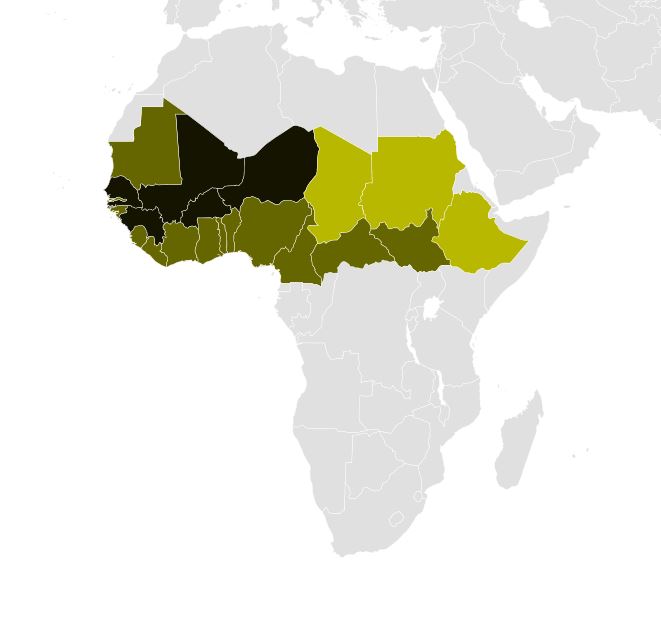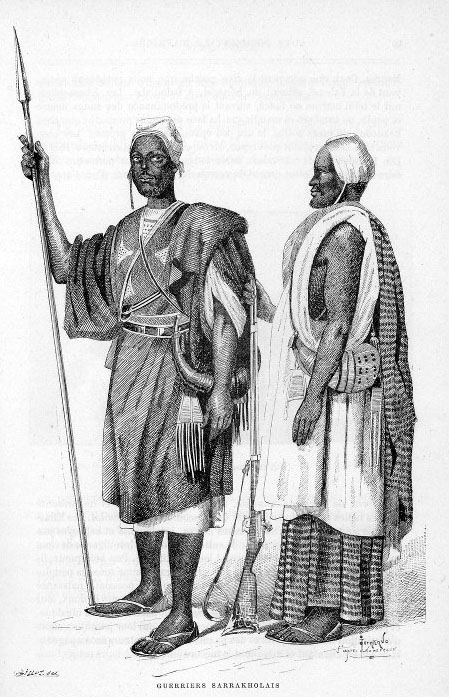|
Vélingara
Vélingara is a city and urban commune situated in the Kolda Region of Senegal. It is located slightly north of the large 48 km Vélingara crater though the structure's impact origin is still unconfirmed.S. Wade, M. Barbieri, J. Lichtenegger (2001The Velingara Circular StructureEsa Bulletin June 2001 The population is primarily composed of Fulani, Soninke, Wolof and Madingo. The population at the 2023 census was 45,431 an increase from the counted 32,161 in 2013. From foundation to the 1940s Vélingara means "If it's good to live, come" in Fulani. The natural assets of this site certainly led Ali Niana Baldé, founder of the village, to settle there. Like the entire Fouladou region, this part was full of game and had fertile land for agriculture. This first village was founded around 1900. According to Elhadji Diao, born in Vélingara Fulbé around 1927, its foundation dates back to an earlier date, probably around 1870. Indeed, on a map of Fouladou from 1880 is mentioned a ... [...More Info...] [...Related Items...] OR: [Wikipedia] [Google] [Baidu] |
List Of Possible Impact Structures On Earth
This list includes potential but unconfirmed structures that are not listed on the Earth Impact Database list of confirmed impact structures. For confirmed impact structures, see List of impact structures on Earth. List of confirmed and possible impact structures The following tables list geological features on Earth that are possible impact events, but for which there is currently no confirming scientific evidence in the peer-reviewed literature. In order for a structure to be List of impact craters on Earth, confirmed as an impact crater, it must meet a stringent set of well-established criteria. Some proposed impact structures are likely to eventually be confirmed, whereas others are likely to be shown to have been misidentified (see below). Recent extensive surveys have been done for Australian (2005), African (2014), and South American (2015) craters, as well as those in the Arab world (2016). A book review by A. Crósta and U. Reimold disputes some of the evidence presente ... [...More Info...] [...Related Items...] OR: [Wikipedia] [Google] [Baidu] |
Communes Of Senegal
The Communes of Senegal are the fourth-level administrative divisions in Senegal (below country, region and department). There are some 121 communes in Senegal which have urban status (''communes de ville''), apart from 46 ''communes d'arrondissement'' in the large towns and 370 List of settlements in Senegal, rural communities (''communautés rurales'') in the countryside. History Dakar Region Dakar Department *Dakar (19 communes d'arrondissement) Guédiawaye Department *Guediawaye (5 communes d'arrondissement) Pikine Department *Pikine (16 communes d'arrondissement) Rufisque Department *Rufisque (3 communes d'arrondissement) *Bargny, Senegal, Bargny *Diamniadio *Sébikhotane *Jaxaay-Parcelle-Niakoul Rap *Sangalkam *Sendou Diourbel Region Bambey Department *Bambey Diourbel Department *Diourbel Mbacké Department *Mbacké Fatick Region Fatick Department *Diakhao *Diofior *Fatick Foundiougne Department *Foundiougne *Karang Poste *Passy (Sénégal), Passy *Sokone *Soum (S ... [...More Info...] [...Related Items...] OR: [Wikipedia] [Google] [Baidu] |
Departments Of Senegal
The 14 regions of Senegal are subdivided into 46 departments and 103 arrondissements (neither of which have administrative function) and by ''collectivités locales'' (the 14 ''régions'', 110 ''communes'', and 320 ''communautés rurales'') which elect administrative officers. Since three new regions increased the number of departments to 45 in 2008, the most recent addition, of Keur Massar, in May 2008 brings the number to 46. The departments are listed below, by region: Dakar region * Dakar department * Guédiawaye department * Keur Massar department (since May 2021) * Pikine department * Rufisque department Diourbel region * Bambey department * Diourbel department * Mbacké department Fatick region * Fatick department * Foundiougne department * Gossas department Kaffrine region * Kaffrine department * Birkilane department * Koungheul department * Malem Hoddar department Kaolack region * Guinguinéo department * Kaolack department * Nioro du Rip departme ... [...More Info...] [...Related Items...] OR: [Wikipedia] [Google] [Baidu] |
Regions Of Senegal
Senegal is subdivided into 14 regions (French: ''régions'', singular''région''), each of which is administered by a ''Conseil Régional'' (pl.: ''Conseils Régionaux'') elected by population weight at the arrondissement An arrondissement (, , ) is any of various administrative divisions of France, Belgium, Haiti, and certain other Francophone countries, as well as the Netherlands. Europe France The 101 French departments are divided into 342 ''arrondissem ... level. Senegal is further subdivided into 46 departments, 103 arrondissements (neither of which have administrative function) and by ''collectivités locales'' (the 14 ''regions'', 110 ''communes'', and 320 ''communautés rurales'') which elect administrative officers. from Union des ''Associations d’ Elus Locaux (UAEL) d ... [...More Info...] [...Related Items...] OR: [Wikipedia] [Google] [Baidu] |
Greenwich Mean Time
Greenwich Mean Time (GMT) is the local mean time at the Royal Observatory, Greenwich, Royal Observatory in Greenwich, London, counted from midnight. At different times in the past, it has been calculated in different ways, including being calculated from noon; as a consequence, it cannot be used to specify a particular time unless a context is given. The term "GMT" is also used as Western European Time, one of the names for the time zone UTC+00:00 and, in UK law, is the basis for civil time in the United Kingdom. Because of Earth's uneven angular velocity in its Elliptic orbit, elliptical orbit and its axial tilt, noon (12:00:00) GMT is rarely the exact moment the Sun crosses the Prime meridian (Greenwich), Greenwich Meridian and reaches its highest point in the sky there. This event may occur up to 16 minutes before or after noon GMT, a discrepancy described by the equation of time. Noon GMT is the annual average (the arithmetic mean) moment of this event, which accounts f ... [...More Info...] [...Related Items...] OR: [Wikipedia] [Google] [Baidu] |
Senegal
Senegal, officially the Republic of Senegal, is the westernmost country in West Africa, situated on the Atlantic Ocean coastline. It borders Mauritania to Mauritania–Senegal border, the north, Mali to Mali–Senegal border, the east, Guinea to Guinea–Senegal border, the southeast and Guinea-Bissau to Guinea-Bissau–Senegal border, the southwest. Senegal nearly surrounds The Gambia, a country occupying a narrow sliver of land along the banks of the Gambia River, which separates Senegal's southern region of Casamance from the rest of the country. It also shares a maritime border with Cape Verde. Senegal's capital is Dakar. Senegal is the westernmost country in the mainland of the Old World, or Afro-Eurasia. It owes its name to the Senegal River, which borders it to the east and north. The climate is typically Sahelian, though there is a wet season, rainy season. Senegal covers a land area of almost and has a population of around 18 million. The state is a Presidential system ... [...More Info...] [...Related Items...] OR: [Wikipedia] [Google] [Baidu] |
Fulani
The Fula, Fulani, or Fulɓe people are an ethnic group in Sahara, Sahel and West Africa, widely dispersed across the region. Inhabiting many countries, they live mainly in West Africa and northern parts of Central Africa, South Sudan, Darfur, and regions near the Red Sea coast in Sudan. The approximate number of Fula people is unknown, due to clashing definitions regarding Fula ethnicity. Various estimates put the figure between 25 and 40 million people worldwide. A significant proportion of the Fula – a third, or an estimated 7 to 10 million – are pastoralists, and their ethnic group has the largest nomadic pastoral community in the world., Quote: The Fulani form the largest pastoral nomadic group in the world. The Bororo'en are noted for the size of their cattle herds. In addition to fully nomadic groups, however, there are also semisedentary Fulani – Fulbe Laddi – who also farm, although they argue that they do so out of necessity, not choice. The majority of the Fu ... [...More Info...] [...Related Items...] OR: [Wikipedia] [Google] [Baidu] |
Soninke People
The Soninke (Sarakolleh) people are a West African Mande languages, Mande-speaking ethnic group found in Mali, southern Mauritania, eastern Senegal, The Gambia, and Guinea (especially Fouta Djallon). They speak the Soninke language, also called the Serakhulle or Azer language, which is one of the Mande languages. Soninke people were the founders of the ancient Ghana Empire, empire of Ghana or Wagadou c. 200–1240 CE, Subgroups of Soninke include the Jakhanke, Maraka and Soninke Wangara, Wangara. When the Ghana empire was destroyed, the resulting diaspora brought Soninkes to Mali, Mauritania, Senegal, Gambia, Burkina Faso, Côte d'Ivoire, Guinée-Conakry, modern-day Republic of Ghana, Kano in Nigeria, and Guinea-Bissau where some of this trading diaspora was called Wangara, leading to the saying “when Americans landed on the moon, a Soninke was already there” in Senegal, with other versions across West Africa. Predominantly Muslims, the Soninke were one of the early ethnic gr ... [...More Info...] [...Related Items...] OR: [Wikipedia] [Google] [Baidu] |
Wolof People
The Wolof people () are a Niger-Congo peoples, Niger-Congo ethnic group native to the Senegambia, Senegambia region of West Africa. Senegambia is today split between western Senegal, northwestern the Gambia, Gambia and coastal Mauritania; the Wolof form the largest ethnic group within Senegambia. In Senegal as a whole, the Wolof are the largest ethnic group (~39.7%), while elsewhere they are a minority. They Endonym and exonym, refer to themselves as ''Wolof'' and speak the Wolof language, in the West Atlantic languages, West Atlantic branch of the Niger–Congo family of languages; English inherited ''Wolof'' as both the adjectival ethnonym and the name of the language. Their early history is unclear. The earliest documented mention of the Wolof is found in the records of 15th-century, Portuguese-financed Italian traveller Alvise Cadamosto, who mentioned well-established Islamic Wolof chiefs advised by Muslim counselors. The Wolof belonged to the medieval-era Wolof Empire of the ... [...More Info...] [...Related Items...] OR: [Wikipedia] [Google] [Baidu] |


